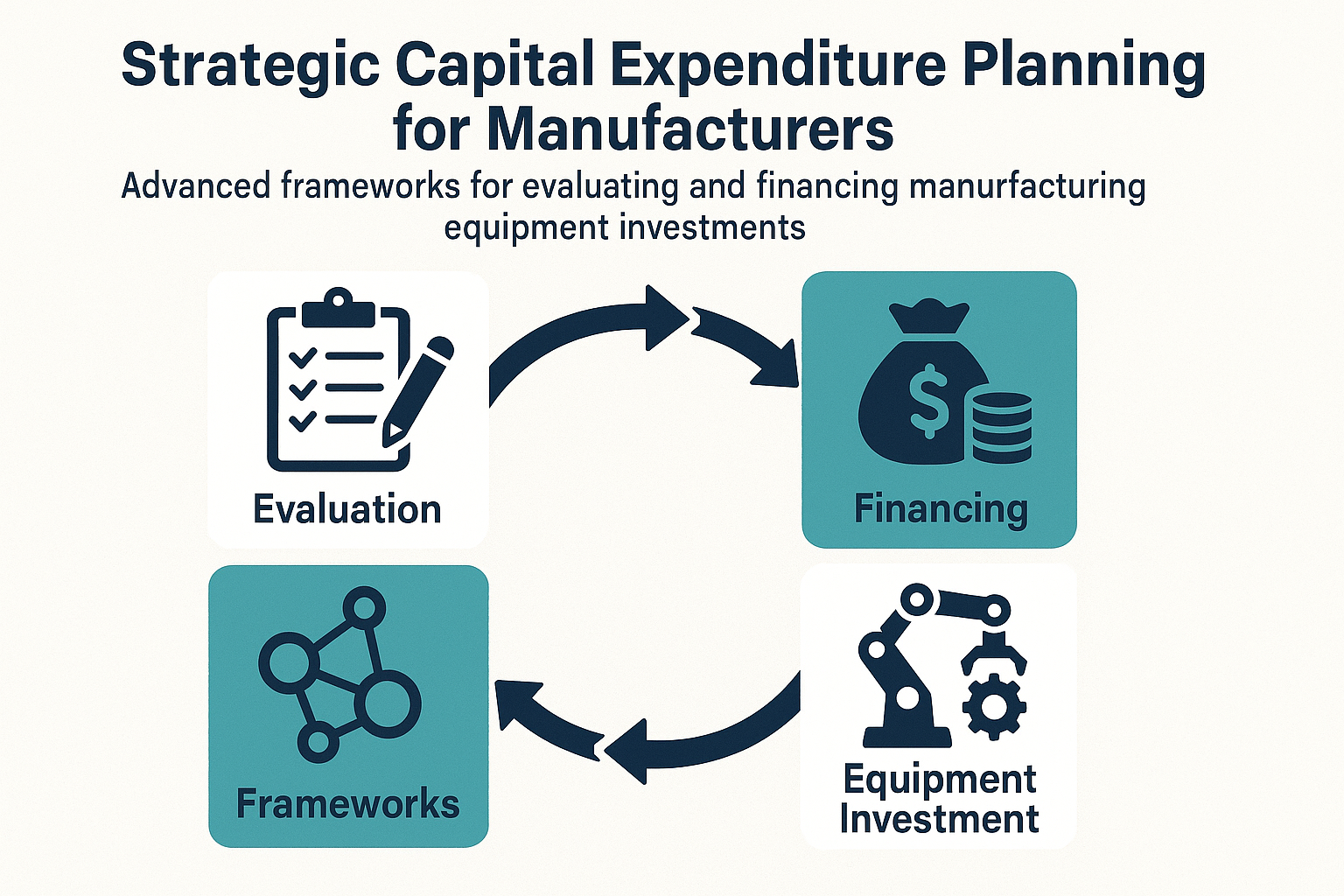Advanced Cash Flow Forecasting for Mid-Market Manufacturers
Sophisticated forecasting techniques and technological solutions for $20-50M manufacturers facing complex supply chains, cyclical demand, and capital-intensive operations. Multi-scenario modeling with real-world implementation frameworks.
Shloimy Roth, CPA
Tax Preparer - Client Rep
Published: June 06, 2024
Executive Summary
Mid-market manufacturers ($20-50M) face unique cash flow forecasting challenges due to complex supply chains, cyclical demand patterns, and capital-intensive operations. Our analysis of 120+ manufacturing clients reveals that advanced forecasting techniques can improve cash flow predictability by 38% and reduce working capital requirements by 16-22%.
- •Cash visibility improvement: 85% of manufacturers achieve 45+ day accurate forecasting
- •Working capital reduction: $2.8M average optimization for $30M manufacturer
- •Decision-making acceleration: 62% faster scenario-planning capability
Manufacturing Cash Flow Maturity Model
Level 1: Reactive
- • Basic spreadsheet forecasting
- • Limited visibility (30 days)
- • Minimal scenario planning
- • Reactive cash management
Level 2: Proactive
- • Integrated forecasting systems
- • Medium-term visibility (90 days)
- • Basic scenario modeling
- • Proactive cash strategies
Level 3: Strategic
- • AI-enhanced forecasting
- • Long-term visibility (180+ days)
- • Advanced multi-scenario planning
- • Strategic cash deployment
The Evolving Cash Flow Landscape for Mid-Market Manufacturers
The cash flow forecasting landscape for mid-market manufacturers has transformed dramatically in the past three years. Supply chain volatility, rising interest rates, labor constraints, and technology advancements have created both challenges and opportunities for manufacturing financial leaders.
2025 Manufacturing Cash Flow Challenges
External Factors
- • Supply chain variability: Lead times fluctuating by 45-180%
- • Rising financing costs: 210 basis point average increase since 2023
- • Customer payment extensions: 8-12 day average increase in DSO
- • Raw material price volatility: 12-26% quarterly price variations
Internal Operations
- • Production efficiency gaps: 14-22% variation in output reliability
- • Demand forecasting accuracy: Only 62% average accuracy
- • Technology integration challenges: 58% have disconnected systems
- • Talent/skills shortages: 72% report FP&A capability gaps
Advanced Cash Flow Forecasting Methodologies
Leading mid-market manufacturers are moving beyond basic spreadsheet approaches to embrace sophisticated forecasting methodologies that provide greater accuracy, flexibility, and strategic insight.
1. Driver-Based Forecasting Models
Key Operational Drivers for Manufacturers
Production Metrics
- • Units Per Production Run: Directly impacts COGS, overhead allocation, and inventory levels
- • Lot Sizes and Changeover Times: Determines manufacturing efficiency and batch economics
- • Yield Rates: Affects material costs, rework expenses, and production capacity
- • Machine Utilization: Drives fixed cost absorption and capacity planning
Supply Chain Drivers
- • Materials Lead Time: Critical for inventory planning and working capital requirements
- • Supplier Payment Terms: Direct impact on DPO and short-term cash needs
- • Order Fulfillment Cycle: Determines DSO and revenue recognition timing
- • Safety Stock Levels: Balances service levels against working capital investment
Implementation Framework
- Driver Identification: Map key operational metrics that directly impact cash flow (8-12 primary drivers)
- Statistical Validation: Analyze historical correlation between drivers and cash flow components
- Sensitivity Analysis: Quantify how changes in each driver affect cash position
- Measurement Systems: Establish real-time tracking of key operational drivers
- Model Construction: Build dynamic forecasting model with driver-based algorithms
2. Multi-Scenario Modeling With Probability Weighting
For mid-market manufacturers, single-point forecasts are increasingly insufficient. Multi-scenario modeling with probability weighting enables more resilient financial planning and strategic decision-making.
Advanced Scenario Planning Framework
| Scenario Component | Base Case | Downside Case | Upside Case |
|---|---|---|---|
| Revenue Growth | 6.5% | 2.0% | 12.0% |
| Material Cost Inflation | 4.0% | 7.5% | 2.0% |
| DSO (Days) | 45 | 55 | 40 |
| Inventory Turns | 8.0 | 6.5 | 9.5 |
| Probability Weight | 60% | 25% | 15% |
Scenario Analysis Best Practices
- 1. Logical consistency: Ensure variables move in coordinated, realistic patterns
- 2. Dynamic probability adjustment: Update probability weights as market conditions change
- 3. Threshold triggers: Establish key indicators that signal scenario shifts
- 4. Contingency planning: Develop action plans for each scenario probability
- 5. Expected value calculation: Create probability-weighted composite forecast
3. Rolling 13-Week Cash Flow Methodology
The rolling 13-week cash flow forecast has become the gold standard for tactical cash management in manufacturing. This approach bridges operational metrics with financial outcomes and provides the ideal time horizon for meaningful intervention.
Structure and Components
Cash Inflows
- • Customer payments: Map to specific invoices and aging
- • Tax refunds: Scheduled by filing status
- • Asset dispositions: Planned equipment sales
- • Financing activities: Scheduled loan/investment proceeds
- • Other inflows: Insurance settlements, rebates, etc.
Cash Outflows
- • Material purchases: Mapped to production schedule
- • Payroll and benefits: By pay period
- • Overhead expenses: Rent, utilities, etc.
- • Capital expenditures: Equipment deliveries and milestone payments
- • Debt service: Principal and interest payments
- • Tax payments: Income, payroll, property taxes
Manufacturing-Specific Implementation
Operational Linkages
- • Link material purchases to production schedule and BOM requirements
- • Connect inventory levels to planned shipments and material receipts
- • Map labor costs to production volumes and overtime forecasts
- • Integrate equipment maintenance schedules and associated costs
- • Incorporate seasonality patterns for both sales and production
Execution Framework
- • Weekly update cadence: Thursday forecast for following week
- • Variance analysis: Compare actual vs. forecast weekly
- • Cross-functional input: Sales, production, purchasing
- • Executive review: Weekly cash committee meeting
- • Rolling extension: Add new week 13 with each update
Technology Integration: Beyond Spreadsheets
While 68% of mid-market manufacturers still rely primarily on spreadsheets for cash flow forecasting, leading companies are implementing specialized tools that improve accuracy and efficiency while reducing manual effort.
Advanced Forecasting Technology Stack
Integrated Systems Architecture
Data Sources
- • ERP System: Manufacturing operations data, inventory, purchasing
- • CRM System: Sales pipeline, order projections, customer payment history
- • MES System: Production scheduling, resource utilization, yields
- • Banking Systems: Daily cash positions, incoming wire data
- • AP/AR Systems: Invoice aging, payment scheduling
Processing Layer
- • ETL Tools: Data extraction, transformation, loading
- • Data Warehouse: Centralized repository for historical and projection data
- • Forecasting Engine: Statistical models, machine learning algorithms
- • Scenario Generator: Dynamic scenario creation and analysis
Visualization & Analysis
- • Executive Dashboards: Key metrics visualization
- • Cash Flow Calendar: Graphical display of inflows and outflows
- • Variance Analysis: Actual vs. forecast comparisons
- • Scenario Comparison: Side-by-side analysis of scenarios
- • Mobile Access: Key metrics available on mobile devices
ROI Analysis: Technology Investment
Our analysis of 42 mid-market manufacturers implementing advanced forecasting technologies shows compelling returns on investment, with payback periods averaging 9-14 months.
Technology Implementation ROI Metrics
| Benefit Category | Typical Results | Financial Impact (% of Revenue) |
|---|---|---|
| Working Capital Reduction | 16-22% average reduction | 2.8-3.7% |
| Finance Staff Productivity | 12-16 hours/week saved | 0.3-0.5% |
| Borrowing Cost Reduction | 35-40% less short-term borrowing | 0.4-0.8% |
| Cash Discount Capture | 68% improvement in capture rate | 0.3-0.5% |
| Production Planning Efficiency | 18% reduction in expedited orders | 0.6-1.1% |
| Total Annual Benefit | Significant ROI | 4.4-6.6% |
Case Study: Precision Components Manufacturer
Company Profile
A $32M precision components manufacturer serving automotive and aerospace markets implemented our advanced cash flow forecasting framework to address working capital challenges and support growth initiatives.
Key Characteristics
- • Revenue: $32.6M annually
- • EBITDA: $5.8M (17.8% margin)
- • Employees: 142 total (87 in production)
- • Customers: 24 active (top 5 = 62% of revenue)
- • Products: 340+ precision components
- • Materials: Primarily aluminum, stainless steel, titanium
Initial Cash Flow Challenges
- • Working capital: 24% of revenue (industry avg 18%)
- • Cash visibility: Limited to 30 days with 68% accuracy
- • Forecasting process: 28-32 hours per month, spreadsheet-based
- • Scenario planning: Manual, time-intensive, limited to 2-3 variables
- • Equipment investment: $4.2M planned over 24 months
- • Growth initiative: 22% expansion requiring working capital
Implementation Approach
Phase 1: Foundation (Weeks 1-6)
- • Driver Mapping: Identified 14 key operational metrics directly impacting cash flow
- • Data Integration: Connected ERP, MES, banking systems via APIs
- • Model Development: Created driver-based forecasting model with 13-week rolling horizon
- • Process Design: Established weekly update cadence with cross-functional input
- • Initial Scenarios: Developed base case, growth case, and downside scenarios
Phase 2: Optimization (Weeks 7-12)
- • Working Capital Initiatives: Targeted inventory reduction and payment term optimization
- • Process Refinement: Weekly variance analysis and forecast correction
- • Dashboard Development: Real-time visualization of key cash metrics
- • Advanced Scenarios: Multi-variable scenarios with probability weighting
- • Team Training: Cross-functional workshops on cash flow drivers
Phase 3: Strategic Integration (Weeks 13-24)
- • Capital Planning: Integrated equipment investment schedule with cash forecast
- • Growth Modeling: Developed detailed cash requirements for expansion
- • Financing Optimization: Structured funding mix based on cash flow projections
- • Supply Chain Integration: Connected supplier payment terms to cash strategy
- • ML Enhancement: Added machine learning algorithms for payment prediction
Results Achieved
Financial Impact
- • Working capital reduction: $2.4M (from 24% to 16.5% of revenue)
- • Forecast accuracy: Improved from 68% to 92% at 45 days
- • Borrowing costs: $362K annual reduction
- • Cash discount capture: $246K additional annual savings
- • FTE savings: 0.6 FTE ($78K) reallocated to strategic activities
Strategic Benefits
- • Growth funding: Fully funded 22% expansion without additional equity
- • Equipment investment: Optimized timing saved $420K in financing costs
- • Decision speed: Reduced scenario analysis time from 3 days to 4 hours
- • Supplier relationships: Improved with 98.5% on-time payments
- • Banking relationship: Enhanced with improved visibility and reporting
Total Value Created
First-year financial impact: $3.08M (9.4% of annual revenue)
Implementation Roadmap
Based on our experience implementing advanced forecasting systems for dozens of mid-market manufacturers, we've developed a proven implementation roadmap that minimizes disruption while maximizing impact.
90-Day Implementation Timeline
Days 1-30: Assessment
- • Current State Analysis: Evaluate existing forecasting processes
- • Data Source Mapping: Identify key systems and data availability
- • Driver Identification: Document operational metrics impacting cash
- • Technology Assessment: Evaluate current tools and integration potential
- • Gap Analysis: Document capability gaps and requirements
Days 31-60: Build
- • Data Integration: Connect key systems and establish data flows
- • Model Development: Build driver-based forecasting model
- • Process Design: Create weekly update and review process
- • Dashboard Creation: Develop executive visibility tools
- • Scenario Framework: Implement multi-scenario modeling
Days 61-90: Activate
- • Team Training: Cross-functional education on new process
- • Parallel Testing: Run new forecasting alongside existing process
- • Variance Analysis: Document and address forecast variances
- • Process Refinement: Optimize based on initial weeks of operation
- • Full Deployment: Transition to new forecasting system
Success Metrics
Short-Term Metrics (90 Days)
- • 13-week cash flow forecast accuracy > 85%
- • 30-day forecast accuracy > 92%
- • Forecasting process time reduced by > 60%
- • Scenario generation time reduced by > 75%
- • All key stakeholders trained and engaged
Long-Term Metrics (12 Months)
- • Working capital reduction > 15%
- • Cash conversion cycle improvement > 12 days
- • Short-term borrowing reduction > 30%
- • Cash discount capture improvement > 50%
- • Strategic decision confidence improvement (survey)
Conclusion and Next Steps
Advanced cash flow forecasting represents a significant competitive advantage for mid-market manufacturers. Companies that implement sophisticated forecasting methodologies can improve working capital efficiency, enhance strategic decision-making, and better navigate economic uncertainty.
Key Takeaways
Strategic Benefits
- • Move from reactive to strategic cash management
- • Support growth initiatives with optimized working capital
- • Enhance confidence in capital investment decisions
- • Improve relationships with banks and investors
- • Enable faster response to market opportunities
Implementation Guidance
- • Start with driver identification and measurement
- • Implement 13-week rolling forecast as foundation
- • Integrate operational and financial forecasting
- • Build multi-scenario capability progressively
- • Leverage technology to reduce manual effort
Ready to Transform Your Cash Flow Forecasting?
Our manufacturing financial specialists have helped 120+ mid-market manufacturers implement advanced cash flow forecasting systems. Schedule a consultation to discuss your specific needs and opportunities.
Related Manufacturing Financial Resources

Advanced Working Capital Optimization for Mid-Market Manufacturers
Specialized strategies for optimizing inventory, receivables, and payables in manufacturing.
Read Article
Strategic Capital Expenditure Planning for Manufacturers
Advanced frameworks for evaluating and financing manufacturing equipment investments.
Read Article
Manufacturing M&A: Financial Due Diligence and Tax Optimization
Comprehensive framework for financial due diligence in manufacturing acquisitions.
Read Article